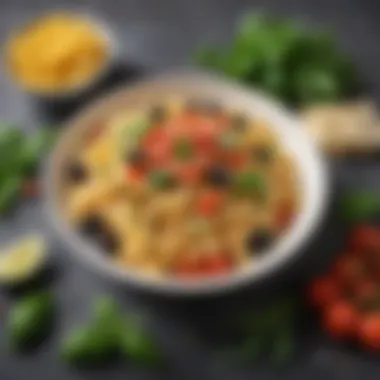Understanding Zero Calorie Pasta: A Comprehensive Guide


Prelims to Zero Calorie Pasta
The rise of health consciousness in modern society has sparked an interest in low-calorie alternatives to traditional foods. Zero calorie pasta represents a pivotal development within this movement, offering similar culinary experiences without the significant caloric load often associated with conventional pasta. This innovation is crucial as it caters to various lifestyles, enhancing meal plans for those seeking to reduce calorie intake. Understanding zero calorie pasta is essential for informed dietary choices.
The Emergence of Low-Calorie Alternatives
As dietary trends evolve, the demand for low-calorie food options continues to grow. Zero calorie pasta derives from innovative food technology that focuses on creating substitutes using ingredients with minimal to no caloric content. This section highlights this product's evolution and how such alternatives address weight management challenges. By substituting traditional pasta with zero-calorie varieties, individuals explore a potential avenue for more extensive dietary achievements. The culinary landscape sees more creativity as brands adapt to meet consumer needs.
- Increasing Health Awareness: Public interest in nutrition and healthy eating fosters demand for effective low-calorie options.
- Technological Advances: Food technology enables the production of flavorsome, low-calorie products that mimic traditional forms without the industry-wide trend of excessive calories.
- Diverse Uses: Zero calorie pasta is versatile. Chefs and home cooks incorporate these pastas into myriad dishes, maintaining the enjoyment of meals despite reduced caloric intake.
The emergence of these alternatives marks a shift that extends beyond calorie counting. It influences aesthetics in dish presentation, design, and flavor appreciation in low-calorie meals. Traditional perceptions of pasta as unhealthy are being dismantled, showcasing that flavorful dining experiences can exist regardless of calorie diminishment.
Understanding Zero Calorie Claims
The term "zero calorie" can be subjective and misleading. It is essential to dissect this claim carefully. The FDA outlines food labeling regulations; for items labeled as calorie-free, each serving must contain fewer than five calories. Brands often use shirataki noodles, derived from konjac root, as a prominent example of zero calorie pasta. Their innate composition facilitates a reduction in calories due to their high water and fiber content.
While discussing zero calorie claims, other factors warrant consideration:
- Servings Matter: Remaining aware of portion sizes is vital. Despite calorie content often reported through one standard serving, overindulging can undermine dietary aspirations.
- Dietary Neglect: Relying solely on these pastas may divert consumers from balanced nutrient consumption, as fulfilling meals require more than just adequate caloric balance.
- Communication Confusion: Marketing might distort perceptions of what constitutes healthy eating. Critical thinking must guide consumers to recognize what products genuinely enhance their dietary profiles.
A clear understanding of zero calorie claims aids customers in navigating this complex marketplace. They remain equipped to make choices reflecting not only personal health but overarching dietary integrity.
Ingredients and Composition of Zero Calorie Pasta
Understanding the ingredients and composition of zero calorie pasta is vital for anyone delving into this modern culinary trend. These factors play a central role in the pasta's unique characteristics, nutritional value, and its appeal to those seeking lower-calorie alternatives. By examining these ingredients closely, one can appreciate the specific benefits and considerations associated with consuming this type of pasta.
Primary Ingredients Used
Konjac Root
Konjac root is one of the primary ingredients in zero calorie pasta. This plant-based component mainly constitutes the glucomannan fiber, which is key to the pasta’s low-caloric impact. One notable characteristic of konjac root is its ability to absorb water, swelling up and providing a bulk-like texture without the calorie content found in traditional pasta. This unique feature makes konjac root a valuable addition for those aiming for weight management.
However, despite its benefits, there are considerations to remember. While it aids in satiety, excessive consumption of konjac can lead to digestive discomfort, bettr balanced use in diet is suggested.
Shirataki Noodles
Shirataki noodles are another significant variant found in zero calorie pasta. These noodles, derived from the same konjac root, are well-known for being virtually calorie-free. Their primary aspect lies in their gelatinous texture, which mimics the feel of wheat pasta without the added calories. Many people favor shirataki noodles for their versatility and adaptability in various dishes, from stir-fries to soups.
They do, conversely, lack in flavor, which can make them less appealing if not paired correctly with seasonings or sauces. This factor highlights the importance of culinary technique when working with Shirataki.
Alternative Fiber Sources
Some manufacturers incorporate alternative fiber flakes into zero calorie pasta, promoting their health benefits as well. Ingredients such as oat fiber or psyllium husk provide distinctive features, including physiologically beneficial properties that promote digestive health. This inclusion aids the nutritional profile, giving an option for consumers seeking fiber-rich meals.
Moreover, their blend can benefit those looking for more diverse options. However, filtering through various pasta brands for their ingredient source can be vital due to maintenance of dietary preferences.
How Ingredients Influence Texture and Flavor
The diverse ingredients found in zero calorie pasta distinctly affect texture and flavor. Each component contributes flavor and mouthfeel to the overall dish. Konjac’s gelatinousness creates a subtle 'chewiness.' On the contrary, the bland characteristics of shirataki noodles require well-balanced seasoning to elevate overall enjoyment.
In brief form:
- Texture Variations: Engaging consistency via konjac promotes a different experience compared to traditional pasta.
- Flavor Profiles: Influence from ingredient seasoning balances potential blandness.
- *** Nurtition Enhanched***: The inclusion of other fiber pushes that edge in health.


In essence, selecting quality ingredients and understanding their respective influences connects central to optimizing a zero calorie pasta meal.
Nutritional Analysis of Zero Calorie Pasta
An in-depth nutritional analysis is crucial in comprehending the value and implications of zero calorie pasta in our diet. Understanding its caloric content and breakdown of macronutrients arrive as significant pillars. This section will aid in appreciating how such pasta interacts with traditional options, revealing not just a different way of consuming cuisine, but a possible alternative for health-focused individuals.
Caloric Content and Macronutrient Breakdown
Zero calorie pasta, often derived from konjac root, presents an atypical profile when it comes to caloric input. The underlying principle of zero calorie claims stems primarily from the minimal amounts of digestible carbohydrates these products contain. A serving typically measures around 200 grams and can have calorie counts as low as 10 to 20 calories, largely attributed to the dietary fiber, which the body uses differently than standard calories.
The breakdown often looks as follows:
- Calories: Around 10 to 20 per serving.
- Carbohydrates: Generally 1 to 5 grams, mostly from fiber.
- Protein: Less than 1 gram.
- Fat: 0 grams.
The dietary fiber—specifically glucomannan found in konjac—can help regulate blood sugar levels and promote a feeling of fullness without adding substantial calorie intake. Essentially, these dietary fibers absorb water, expanding in the gut and thus contributing to satiety.
In relation to how this shifts daily dietary habits, individuals on weight loss journeys often find that including zero calorie pasta allows them to enjoy larger portions of meals with significantly reduced overall caloric counts. It's not only about cutting calories but balancing energy intakes while enjoying the comforting textures of pasta dishes.
Comparative Analysis with Traditional Pasta
When setting zero calorie pasta alongside traditional pasta, stark distinctions reveal themselves. Traditional varieties like wheat pasta typically run between 200 to 220 calories per serving. Also, they provide a more balanced distribution of macronutrients. Thus, a standard serving contains:
- Calories: 200 to 220
- Carbohydrates: About 42 grams
- Protein: Around 7 grams
- Fat: Approximately 1 gram
Comparing these figures, the contrast in caloric and macronutrient compositions becomes evident. Zero calorie pasta appeals particularly to those seeking to cut back calories for weight management. However, one must consider if this trade-off for lack of protein and other nutrients serves satisfactory routes long-term. Traditional pasta can provide more satisfying meals richer in various nutrients, supporting a balanced diet.
Interesting observations surface in kitchen settings where culinary habits emerge. Despite the low calorie aspect of zero calorie pasta, chefs will face challenges integrating these alternatives seamlessly into meals without losing flavor or nutritional depth. Therefore, understanding where to incorporate zariously can make a significant impact in benefiting from both forms depending on one’s dietary goals.
Health Implications of Consuming Zero Calorie Pasta
Zero calorie pasta is being viewed with increased interest, especially in respect of its health implications. The topic aims to shed light on the benefits and risks associated with including this type of food into one's diet. As more people adopt alternative ingredients for health reasons, understanding the balance between benefits and a possible down side is vital.
Potential Health Benefits
Weight Loss Support
Weight loss support is a popular aspect of zero calorie pasta. The effective reduction of caloric malt tends to lead individuals to eat less overall. Because zero calorie pasta is predominantly water-based, portions are visually satisfying without the corresponding caloric intake. This characteristic is advantageous for dieters seeking to control portion sizes while still enjoying meals. Research suggests that foods that fill up without adding calories can promote satiety. Therefore, people actively seeking weight loss appreciate the incorporation of zero calorie pasta in their diets.
Digestive Health Benefits
Digestive health benefits are a relevant feature of consuming zero calorie pasta. Many varieties, especially those based on konjac, contain soluble fibers like glucomannan. These fibers contribute to digestive health by promoting better gut motility. This means that incorporating zero calorie pasta may help alleviate constipation and support overall gut health. Soluble fibers can also aid in nourishing the good bacteria in the gut, which is essential for general health and immunity. Hence, it becomes a beneficial choice for those attentive to their digestive systems.
Possible Risks and Considerations
Nutrient Deficiency
Nutrient deficiency is an important consideration when consuming zero calorie pasta. As it lacks substantial nutrients, those relying solely on it for meals might miss essential vitamins and minerals vital for overall well-being. This may lead to poor nutritional balance if the pasta substitutes more nutrient-rich foods rather than complementing them. Where this product lacks in vital nutrients, individuals must ensure they seek alternative sources to fill any gaps left behind. Relying solely on such pasta can multiply the risk of deficiencies in critical nutrients over time.
Gastrointestinal Issues
Gastrointestinal issues can arise from excessive intake of zero calorie pasta, largely due to its fiber composition. For some individuals, consuming large amounts can lead to discomfort. Bloating and gas are common trambling at the initial introduction of konjac-based products, especially if meals are not properly balanced with adequate hydration and other fiber sources. Therefore, while it offers benefits, caution is prudent in its consume to minimize discomfort. It’s essential for consumers to listen to their bodies when first incorporating zero calorie pasta into their meals.
Understanding both the benefits and shortcomings is key while integrating zero calorie pasta into a balanced diet.
Culinary Techniques for Using Zero Calorie Pasta


Zero calorie pasta is a versatile ingredient that can be utilized in various cuisines and preparations. Understanding culinary techniques is essential for maximizing its potential. Appropriately cooking and incorporating zero calorie pasta into dishes can enhance flavor and texture, allowing it to be more satisfying. This section outlines various preparation methods and creative applications, which will contribute significantly to user experience.
Preparation and Cooking Methods
Rinsing and Sautéing
Rinsing and sautéing zero calorie pasta is a fundamental step that should not be overlooked. This method is essential as it helps eliminate any residual odor from the pasta, particularly the konjac variety. Good rinsing enhances the overall eating experience. In addition, sautéing offers a chance to integrate different flavors, which can turn a bland ingredient into a delicious dish.
It's noteworthy that sautéing infuses zero calorie pasta with tastes from added vegetables and sauces. This technique is beneficial because it enhances flavor without adding significant calories. However, excessive sautéing can lead to uneven textures. A gentler touch can yield better outcomes.
Flavor Enhancements
Flavor enhancements are crucial for enjoying zero calorie pasta. Due to its base nature, it easily absorbs the essences of sauces and spices. Adding freshly chopped herbs, garlic, or other flavor-imparting items can elevate the dish remarkably. Those flavor enhancements allow recipes to be more dynamic, making nutrient density nearly equal to traditional pasta meals.
Incorporating bursts of flavors serves well, but a balance must be confronted Too much seasoning can overpower the subtlety of the dish and lead to an imbalanced presentation.
Incorporating Into Dishes
Incorporating zero calorie pasta into various dishes demonstrates its flexibility. The ability to experiment with recipes reinforces its appeal. Here, we analyze different ways to integrate pasta into familiar culinary constructs.
Salads
Adding zero calorie pasta to salads is a fresh and nutritious choice, providing bulk without adding calories. The key characteristic of salads with this pasta is their refreshing quality combined with texture. This vast characteristic helps blend vibrant vegetables and dressings seamlessly.
Salads are beneficial, especially for those seeking low-calorie yet filling meals. However, a concern may arise if other accompaniments are equally low in nutrients, which may lead toward nutrient-deficient meals over time.
Soups
Using zero calorie pasta in soups transforms the traditional way this dish is enjoyed. It serves as a hearty addition, contributing to the overall volume without significantly raising caloric values. Important to note: soups offer hydration and façade. This balance makes it an appealing meal choice, particularly during colder months.
The main features of incorporating pasta into soups are its adaptability and grounding appearance. While the pasta may help bulk the soup, one must ensure that other proteins and vegetables are utilized effectively, or the final dish may end up less nourishing than anticipated.
Stir-Fries
Stir-fries easily accommodate zero calorie pasta, making it a fun and quick meal option. The characteristic of stir-fries lies in their speed and availability of single pan cooking. It allows use of preserved seasonal vegetables, showcasing simplicity and efficacy as a popular culinary technique.
This method remains beneficial as meals can be prepared efficiently. Yet caution is necessary. Overcooking can lead to mushy pasta, potentially negating its defining qualities.
Overall, cooking techniques greatly determine how zero calorie pasta contributes to improved meals. Mapping clever techniques and appealing combinations can ensure users enjoy diverse and satisfying diet options.
Consumer Perspectives and Market Trends
Consumer attitudes toward zero calorie pasta reflect the evolving demands of modern dietary lifestyles. Interest in low-calorie and health-conscious food items indicates a substantial movement towards innovative culinary options. An analysis of consumer perspectives reveals a strong desire for alternatives that facilitate weight management while maintaining taste and satiety.
Popularity Among Dietary Communities
Keto
Keto diets, characterized by their low carbohydrate and high-fat content, have gained notable traction among those seeking to lose weight without sacrificing taste. Zero calorie pasta serves as a stellar alternative because it allows individuals on keto to enjoy pasta-like dishes minus the carbohydrates. This quality complements their primary goal of maintaining ketosis, a metabolic state beneficial for fat loss.
The unique characteristic of keto is its focus on fat as the main energy source. Low-carb options resonate well with dieters seeking to indulge in familiar foods like pasta without compromising their dietary parameters. However, this could lead to nutrient insufficiencies if zero calorie pasta is consumed excessively without adequate nutritional diversity.
Paleo


Paleo dieters emphasize a natural diet reflecting pre-agricultural food habits. While traditional pasta often does not fit this model, zero calorie pasta made from natural fibers aligns more closely with these dietary principles. The shift towards whole, unprocessed foods makes it appealing as it positions itself as less processed than regular noodles.
Nonetheless, the inclusion of zero calorie pasta must be done judiciously since not all varieties fit neatly into the paleo framework. It is vital to check ingredients and ensure they align with dietary preferences, avoiding gelatinized products that harbor undesirable additives.
Vegan Options
The rise of veganism signals a revolution in dietary preferences as individuals seek plant-based alternatives. Zero calorie pasta satisfies this demand, offering a product that aligns with vegan ideologies while supporting weight management goals. Its versatility integrates well with various plant-based sauces and toppings - a composite feature highly regarded by this community.
A genuine advantage of vegan options in the zero calorie category is their high fiber content, facilitating digestive health when included in diverse diets. However, the reliance on such alternatives necessitates awareness of complete protein sources to ensure balanced nutrition—as pasta alone may not satisfy all dietary needs.
Future Trends in Zero Calorie Products
Looking ahead, the trend towards zero calorie products suggests an increased focus on clean labels and transparency in food sourcing. The pressure to meet consumer demands could prompt manufacturers to enhance their formulations, incorporating various natural ingredients that align with health-focused lifestyles. Notably, as people continue exploring unique ingredient variants from konjac to chickpea flours, the innovation around zero calorie noodles may diversify even further.
Additionally, anticipation towards gaining certifications or endorsements for additional health claims could play a role in ensuring credibility in this marketplace, paving avenues for growth and broader consumer acceptance. > Acknowledging the shifting landscape, both culinary enthusiasts and health seekers have motivated considerable market movement.
Practical Tips for Busy Individuals
In today's fast-paced world, many individuals seek out meal options that not only cater to dietary needs but also align with a busy lifestyle. A common aim for those selecting zero calorie pasta is to maintain a healthy diet while not sacrificing on time. The strategies discussed here can be a game-changer for busy individuals wanting ease and efficiency in meal preparation without compromising nutritional value.
Time-Saving Cooking Strategies
Batch Cooking
Batch cooking involves preparing larger portions of meals in advance and storing them for future use. This method allows individuals to make enough meals for multiple days, which can significantly reduce the daily time spent on cooking. The key benefit of batch cooking is convenience. By investing a few hours once or twice a week, busy people can have healthy meals ready at a moment's notice.
One unique aspect of batch cooking with zero calorie pasta is its ability to adapt to various dishes. Whether you are incorporating it into stir-fries, salads, or soups, it's relatively easy to prepare slightly larger quantities that can be divided into multiple meals. Some may find that the process initially takes time, but the long-term time saving and healthier eating habits it promotes are worth it. Users can customize flavor profiles and combinations as desired, maximizing variety in their diet.
Meal Prep Ideas
Meal prep is a vital complement to batch cooking, focusing on the assembly and packaging of meals ahead of time. This method attracts busy individuals because it ensures that they always have healthful options on hand. One of the main characteristics of meal prep is that it encourages variety while simplifying the week’s efforts to eat well.
When integrating zero calorie pasta into meal prep, different dishes can be planned and prepared using versatile ingredients. What is unique about this approach is you can create different colored containers for various meals or sauces, fades monotony in diets, and can make eating healthy almost effortless.
Some important advantages of meal prep include portion control, reduced food waste, and adherence to dietary goals. However, busy individuals must take care to balance flavors as they store meals. Ingredients might blend together over time, potentially impacting the dish's texture and flavor if not stored properly.
Balancing Zero Calorie Pasta with Other Nutrients
Achieving a balanced diet involves integrating zero calorie pasta with other food options rich in macronutrients and micronutrients. It is essential to acknowledge that while zero calorie pasta can reduce caloric intake, fuelig the body with a whole range of nutrients remains crucial. This product should ideally be part of a larger, well-rounded meal that includes proteins, fats, and carbohydrates from other sources. Adding proteins, for example, through lean meat, vegetables, or legumes enhances the meal's satiety and nutritional density.
In summary, both batch cooking and meal prepping serve foundational roles in efficient meal preparation strategies. When wearing the busy hat, daily challenges lessen with supportive practices like these. Overall, proper balancing of zero calorie pasta with additional nutrients helps ensure both healthful eating and valuable time–an essential combination for anyone on the go.
Ending: The Role of Zero Calorie Pasta in Modern Dining
The evolving landscape of dietary options has led to increasing interest in zero calorie pasta. Its importance cannot be understated for those keen on staying fit while enjoying their favorite meals. Zero calorie pasta provides a viable alternative to traditional options, allowing individuals to explore various culinary possibilities without the burden of excessive calories.
Primarily utilized within a number of dietary frameworks such as keto, paleo, and vegan, zero calorie pasta accommodates numerous lifestyle choices. Many people identify this product as essential in achieving their nutritional goals, all while satisfying their cravings. The ability to fabricate familiar recipes in a healthier way makes zero calorie pasta appealing to a broad spectrum of eaters.
Research suggests calling attention to the following benefits:
- Weight Management: The low caloric intake can support weight loss efforts when incorporated judiciously into meals.
- Versatility: From salads to stews, zero calorie pasta blends easily, making it a simple yet effective ingredient.
- Fiber-Rich Alternatives: While traditional pasta lacks fiber, some options like konjac, provide necessary dietary fiber, promoting digestive well-being.
However, a prudent approach is critical as with any food choice. Not every zero calorie pasta is made equal, and awareness of quality matters. Individuals should always take a closer look at ingredient labels to ensure their selection meets personal dietary needs, especially considering possible nutrient deficiencies from a highly processed diet.
Moreover, the modern kitchen has adapted significantly to these nutritional innovations. The ease of preparation and variety enhances everyday cooking choices, establishing zero calorie pasta as a staple for many.
Embracing innovations in food technology, zero calorie pasta contributes not only to dietary trends but also enhances culinary pleasure without the guilt.
In summary, zero calorie pasta plays a vital role in modern dining. Its presence reflects broader changes in nutritional awareness. By being astute consumers, people can enjoy this ingredient's flexibility, integrate it meaningfully into their meals, and successfully navigate its potential pitfalls. This way, zero calorie pasta has firmly positioned itself in contemporary cuisine, appealing to a conscientious audience keen on health.
Researching credible platforms like Britannica or discussing on Reddit can provide a broader context and perspectives, helping users make informed decisions in culinary practices.







